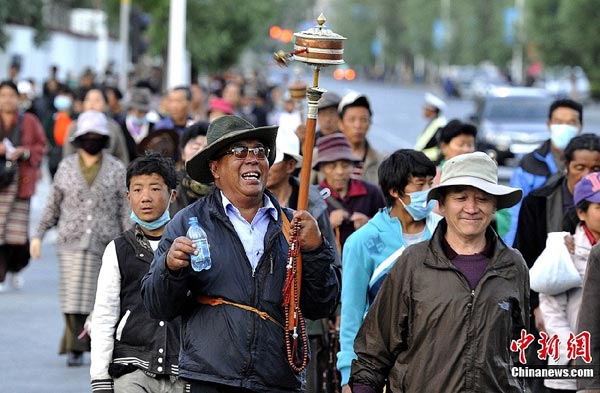
Pilgrims were talking ritual walk along the most popular path Lingkor Street, June 4, 2012. [Photo by Li Lin/ China News Agency]
The Tibetan Buddhist festival Sagya Dawa of year 2012 reached the peak on June 4, Xinhua News Agency reported.
Since the early morning of 4th, Tibetan Buddhist followers flocked to the main paths of pilgrimage in Lhasa, capital of southwest China's Tibet Autonomous Region.
Tsering Chotso, a souvenir dealer from Lhasa's biggest business block Barkor Street, shuttered her shop to take ritual walk, "I was always too busy, but today is the most important day of Sagya Dawa, I must come and pray for my family."
Jokhang Monastery, the monastery housing Buddha's statue in Lhasa, received about 4,000 pilgrims on the peak day, a senior Lama and deputy of the Jokhang Monastery Committee Lhapa told the reporter.
The authority of Lhasa had set up service stations along the busy ritual walk paths, providing medical service and beverage for the pilgrims.
Traffic administration had arranged temporary service points on the crossroads along the Lingkor Street to direct the traffic flow.
Lingkor Street, known as Lhasa's longest ritual walk path, and Zikor Street which is the path around Potala Palace, attracted the most pilgrims.
Pilgrims marched in flows, turning their prayer wheels and beads, chanting Buddhist scriptures for blessing and good fortune, and some of them would prostrate on the ground to do kowtows to the Buddha.
Pilgrims were diverse in age, including the elders dressed in traditional Tibetan clothes, fashionable young people and parents pushing baby strollers.
The Sagya Dawa Festival is a traditional Tibetan festival to commemorate the birth, enlightenment and the nirvana of Sakyamuni, the founder of Buddhism. It started on May 21th this year and reached the peak on June 4th in this year.
(Dekyi from Xinhua News Angency contributed to this report)
